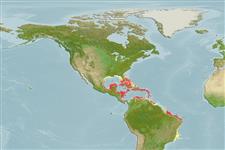>
Perciformes/Serranoidei (Groupers) >
Grammistidae (Soapfishes)
Etymology: Pseudogramma: Greek, pseudes = false + Greek, gramma = letter, signal (Ref. 45335).
Eponymy: Dr William King Gregory (1876–1970) was an American zoologist, primatologist and palaeontologist. [...] (Ref. 128868), visit book page.
Environment: milieu / climate zone / depth range / distribution range
Ökologie
seewasser riff-verbunden; tiefenbereich 1 - 70 m (Ref. 27020). Tropical; 32°N -
Western Atlantic: Bermuda, southern Florida in USA and Bahamas to northern South America. Also Antilles and Yucatan (Ref. 26938).
Size / Gewicht / Alter
Maturity: Lm ? range ? - ? cm
Max length : 7.5 cm TL Männchen/unbestimmt; (Ref. 7251)
Rückenflossenstacheln (insgesamt) : 7; Rückenflossenweichstrahlen (insgesamt) : 18 - 19; Afterflossenstacheln: 3; Afterflossenweichstrahlen: 14 - 16; Wirbelzahl: 26. Live adults dark reddish brown with pale reddish blotches; opercular spot black. Side of lips with a dark-edged whitish bar. Dark red dots extending posteriorly from the eye absent. Adults with a broad-based, slender, triangular, dermal flap dorsally on eye. A pair of large pores in interorbital space, one on each side close to the edge of the orbit; a small median pore posteriorly in interorbital space. Tubular anterior nostril when laid back slightly more than half distance to posterior nostril; when projecting forward, about 1/4 distance from edge of snout to edge of orbit, just reaching groove at base of upper lip. Second lateral line not fully developed. Longitudinal scale series 42-46.
Maximum depth from Ref. 126840. Inhabits areas with live coral. Common in rubble but secretive (Ref. 9710). Feeds on crustaceans and polychaetes (Ref. 27020).
Life cycle and mating behavior
Geschlechtsreife | Fortpflanzung | Ablaichen | Eier | Fecundity | Larven
Randall, J.E. and C.C. Baldwin, 1997. Revision of the serranid fishes of the subtribe Pseudogrammina, with descriptions of five new species. Indo-Pac. Fish. (26):56 p. (Ref. 27020)
IUCN Rote Liste Status (Ref. 130435: Version 2024-1)
Bedrohung für Menschen
Harmless
Nutzung durch Menschen
Fischereien: kommerziell; Aquarium: Kommerziell
Tools
Zusatzinformationen
Download XML
Internet Quellen
Estimates based on models
Preferred temperature (Ref.
123201): 25.5 - 28, mean 27.2 °C (based on 232 cells).
Phylogenetic diversity index (Ref.
82804): PD
50 = 0.5001 [Uniqueness, from 0.5 = low to 2.0 = high].
Bayesian length-weight: a=0.01148 (0.00443 - 0.02975), b=3.06 (2.84 - 3.28), in cm total length, based on LWR estimates for this (Sub)family-body shape (Ref.
93245).
Trophic level (Ref.
69278): 3.3 ±0.40 se; based on food items.
Fishing Vulnerability (Ref.
59153): Low vulnerability (10 of 100).
Nutrients (Ref.
124155): Calcium = 145 [75, 300] mg/100g; Iron = 0.971 [0.505, 1.731] mg/100g; Protein = 18.1 [16.2, 19.8] %; Omega3 = 0.19 [0.11, 0.33] g/100g; Selenium = 29.9 [15.6, 58.8] μg/100g; VitaminA = 134 [43, 457] μg/100g; Zinc = 2.16 [1.41, 3.18] mg/100g (wet weight);
